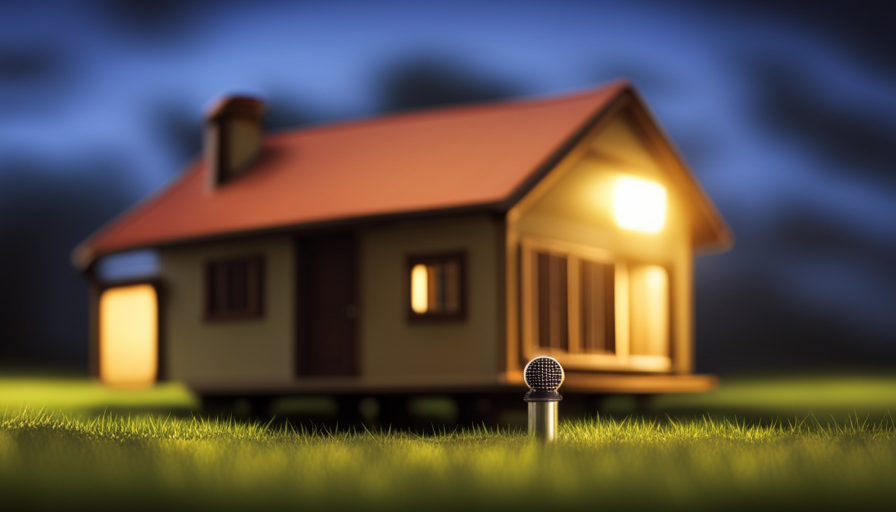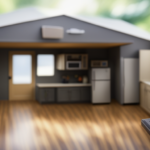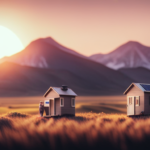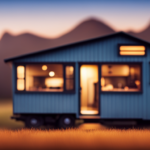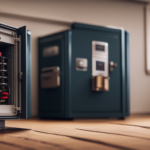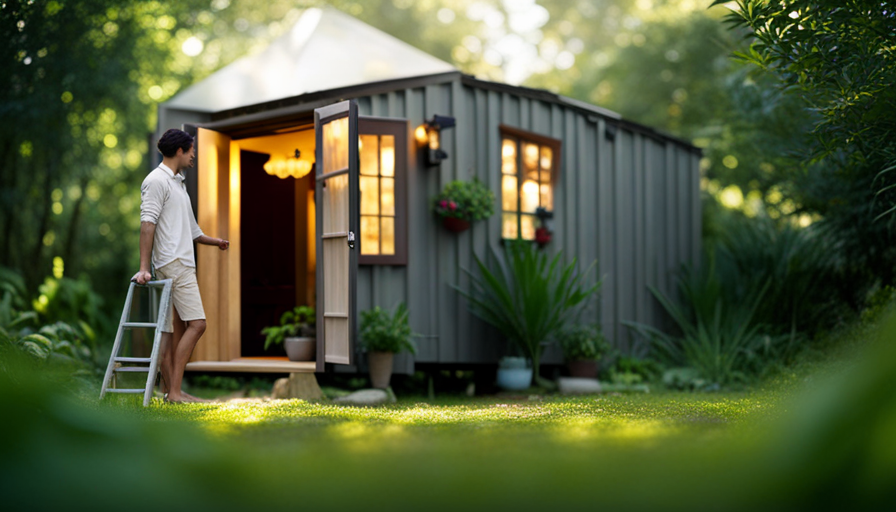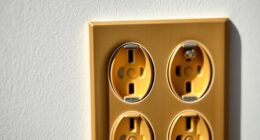“The best things come in small packages” is a well-known phrase that rings true when it comes to tiny homes. These small dwellings have become increasingly popular due to their simplicity, affordability, and environmental friendliness. One common question that arises is about the electrical usage of a tiny house: How many amps does a tiny house typically use?
In this article, I will delve into the intricacies of electrical systems in tiny houses and provide you with a comprehensive understanding of their power requirements. We will explore topics such as calculating the electrical load of a tiny house, choosing the right electrical setup, energy efficiency measures, managing electrical usage, common issues faced by tiny house owners, adapting to different electrical hookups, budgeting for upgrades and maintenance, and even touch upon future trends in tiny house electrical systems.
So whether you’re planning to build your own little haven or simply curious about these pint-sized abodes’ power needs, join me on this journey as we unravel the fascinating world of amps in tiny houses.
Key Takeaways
- Tiny houses require calculating the electrical load by adding up power requirements of all appliances and devices.
- Smart home technology can be used in tiny houses for energy efficiency and optimizing power consumption.
- Energy-saving habits like turning off lights and using energy-efficient appliances are important in tiny houses.
- Tiny house owners should ensure electrical safety by following electrical code compliance and safety standards.
Understanding Electrical Systems in Tiny Houses
So, how many amps does a tiny house typically use? When it comes to understanding electrical systems in tiny houses, it’s important to consider the electrical capacity and the available power options.
Tiny houses usually have limited space and resources, so calculating the electrical capacity is crucial. One option for powering a tiny house is solar power. Solar panels can generate electricity from sunlight and store it in batteries for later use. This renewable energy source allows tiny house owners to be self-sufficient and reduce their reliance on traditional power grids.
When considering solar power options, it’s essential to calculate the electrical load of a tiny house. This involves determining the total amount of electricity needed for all appliances, lighting fixtures, and other electrical devices used in the house. By assessing each item’s wattage and usage time, you can estimate the average daily energy consumption.
Transitioning into the next section about calculating the electrical load of a tiny house, it is important to understand that proper calculation ensures that your electrical system can handle all your needs without overloading or causing any safety issues.
Calculating the Electrical Load of a Tiny House
To calculate the electrical load of your compact abode, simply add up the power requirements of all your appliances and devices. This process is crucial in determining the electrical capacity estimation for your tiny house.
Start by making a list of all the appliances and devices you plan to use in your space, including lights, refrigerator, microwave, air conditioner, and any other items that require electricity. Look at the labels or user manuals for each item to find their power consumption in watts or amps.
Once you have gathered this information, add up the power requirements of each appliance or device. For example, if your refrigerator uses 100 watts and your air conditioner uses 500 watts, your total power requirement would be 600 watts.
Keep in mind that some appliances may have different power requirements depending on whether they are running at full capacity or not. Be sure to account for these variations when calculating the electrical load.
Calculating electrical load is essential for determining how much electricity your tiny house will need. By adding up the power requirements of all your appliances and devices, you can ensure that you choose the right electrical setup for your compact living space without overloading it with excessive electricity usage.
Choosing the Right Electrical Setup for Your Tiny House
Selecting the perfect electrical setup for your cozy home will ensure a seamless and worry-free experience, allowing you to fully embrace the comforts of modern living. When it comes to choosing the right electrical setup for your tiny house, there are a few key factors to consider.
Firstly, power consumption optimization is essential in order to make the most efficient use of electricity. This involves selecting energy-efficient appliances and lighting fixtures that consume minimal electricity without sacrificing functionality or comfort. Additionally, implementing smart home technology can help automate and optimize energy usage, further reducing power consumption.
Secondly, renewable energy integration should be considered as an eco-friendly option for powering your tiny house. Installing solar panels on the roof can generate clean and sustainable electricity that can power your home during daylight hours. This not only reduces reliance on traditional grid electricity but also lowers overall energy costs in the long run.
Lastly, incorporating a battery storage system allows you to store excess solar energy generated during the day for use at night or during cloudy days when solar production may be limited. This ensures continuous power supply without relying solely on solar panels.
Selecting the right electrical setup for your tiny house involves optimizing power consumption and integrating renewable energy sources such as solar panels and battery storage systems. These choices will not only provide reliable and efficient power but also contribute to a more sustainable lifestyle.
Transitioning into the next section about "energy efficiency in tiny houses," we will explore additional ways to maximize efficiency and minimize environmental impact.
Energy Efficiency in Tiny Houses
Optimizing power consumption and integrating renewable energy sources, such as solar panels and battery storage systems, is crucial for achieving energy efficiency in tiny houses. To maximize energy savings, it’s essential to choose energy-saving appliances that are designed specifically for small spaces. These appliances are designed to use less electricity without compromising functionality.
One of the key components of an energy-efficient tiny house is the integration of solar power. Solar panels can be installed on the roof or in a nearby location to harness sunlight and convert it into usable electricity. This renewable energy source not only reduces reliance on the grid but also helps lower utility costs.
In addition to solar power integration, proper insulation plays a vital role in minimizing heat loss or gain in a tiny house. By insulating walls, ceilings, and floors effectively, you can reduce the need for excessive heating or cooling.
Furthermore, implementing smart home technology can enhance energy efficiency. Smart thermostats and lighting systems allow precise control over temperature settings and lighting levels, ensuring that energy is used only when needed.
Managing electrical usage in a tiny house involves monitoring power consumption regularly and making adjustments as necessary. It requires being mindful of turning off lights when not in use and using appliances judiciously.
By incorporating these strategies for optimizing power consumption and integrating renewable energy sources like solar panels, you can achieve significant energy efficiency in your tiny house while reducing your environmental impact.
Managing Electrical Usage in a Tiny House
When it comes to managing electrical usage in a tiny house, there are three key points to consider. First, prioritizing power needs is crucial in order to ensure that the most essential appliances and devices receive adequate electricity.
Second, implementing smart energy management systems can help optimize energy use by automatically adjusting power allocation based on real-time needs.
Lastly, developing energy-saving habits such as turning off lights when not in use and using energy-efficient appliances can significantly reduce overall electrical consumption.
Prioritizing Power Needs
Make sure you prioritize your power needs in your tiny house by determining how many amps you’ll need for all of your appliances and devices. To effectively manage electrical usage, consider the following steps:
-
Identify essential appliances: Determine which appliances are absolutely necessary and calculate their power requirements in amps.
-
Optimize energy efficiency: Choose energy-efficient appliances that consume fewer amps while still meeting your needs.
-
Use alternative power sources: Explore options like solar panels or wind turbines to reduce reliance on the grid and minimize amp usage.
-
Consider multi-purpose devices: Invest in appliances that serve multiple functions, such as a combination washer-dryer or a convection microwave.
By prioritizing power usage and maximizing energy efficiency, you can ensure that your tiny house operates smoothly while utilizing minimal amps. This approach sets the stage for implementing smart energy management systems to further optimize power consumption without compromising comfort or convenience.
Smart Energy Management Systems
In order to effectively prioritize power needs in a tiny house, it is essential to implement smart energy management systems. These systems utilize advanced technologies and smart home automation to optimize energy usage and ensure efficient power distribution. One key component of these systems is energy monitoring, which provides real-time data on the electricity consumption of different appliances and devices in the house. By tracking this information, homeowners can identify high-energy consuming devices and make informed decisions about their usage. To illustrate the benefits of smart energy management systems, consider the following table:
| Appliance | Power Consumption (Watts) |
|---|---|
| Refrigerator | 150 |
| Air Conditioner | 1200 |
| Lighting | 60 |
| Television | 200 |
By utilizing such systems, homeowners can actively manage their power usage and make adjustments accordingly. This lays a solid foundation for adopting energy-saving habits that we will explore further in the subsequent section without breaking continuity.
Energy-Saving Habits
To maximize energy efficiency in your tiny house, adopting energy-saving habits is crucial. By incorporating these energy-saving techniques, you can significantly reduce electricity consumption and minimize your ecological footprint. Here are five simple yet effective habits to help you achieve this goal:
- Turn off lights and unplug electronic devices when they’re not in use.
- Utilize natural lighting during the day to minimize reliance on artificial lighting.
- Opt for energy-efficient appliances that have a lower power draw.
- Insulate your tiny house properly to maintain a comfortable temperature without excessive heating or cooling.
- Use smart power strips to prevent standby power consumption.
By implementing these practices, you can enjoy both cost savings and environmental benefits.
Transitioning into the subsequent section about electrical safety considerations for tiny houses, it’s important to ensure that all electrical systems are installed and maintained correctly for safe usage.
Electrical Safety Considerations for Tiny Houses
With the electrical safety considerations for tiny houses, it’s like navigating through a maze of currents to determine just how many amps are needed. Ensuring electrical code compliance and following electrical safety standards is crucial to prevent hazards in these compact living spaces. To better understand the power requirements, let’s take a look at a table comparing typical electrical appliances and their corresponding amp ratings:
| Appliance | Amp Rating |
|---|---|
| Refrigerator | 3-5 |
| Electric Stove | 20-50 |
| Microwave Oven | 10-15 |
| Air Conditioner | 15-30 |
By referencing this table, you can estimate the total amp usage by summing up the individual ratings of your appliances. It is essential to ensure that your tiny house’s electrical system can handle the total amp load without overloading or causing potential fire hazards.
Moving forward into the subsequent section about common electrical issues in tiny houses, it is important to be aware of these concerns to maintain a safe and functional environment for your small home.
Common Electrical Issues in Tiny Houses
Navigating the realm of electrical systems in your compact living space requires an understanding of the common issues that can arise. Tiny houses, with their limited space and unique electrical setups, are not exempt from experiencing electrical problems.
Common electrical problems in tiny houses include circuit overloads, faulty wiring, and inadequate power supply. Circuit overloads occur when too many appliances or devices are connected to a single circuit, leading to tripped breakers or blown fuses. Faulty wiring can manifest as flickering lights, outlets not working properly, or even potential fire hazards. Inadequate power supply may result in insufficient electricity for all your needs.
To address these common issues, troubleshooting methods such as checking for overloaded circuits, inspecting wiring connections for any loose or damaged components, and ensuring proper grounding and insulation are crucial. It’s also important to understand your tiny house’s electrical system and its limitations.
Transitioning into the subsequent section about adapting to different electrical hookups requires considering how to connect your tiny house safely to external power sources without compromising its internal electrical setup.
Adapting to Different Electrical Hookups
When it comes to adapting to different electrical hookups in a tiny house, there are three key points to consider:
-
RV park connections are important because they provide a reliable source of power for your tiny house when parked at an RV campground.
-
Generators and backup power sources are crucial for those times when you can’t connect to an external power source, ensuring that your tiny house remains functional.
-
Finally, having the right extension cords and adapters is essential for safely connecting your tiny house to different types of electrical outlets.
RV Park Connections
To determine the amps used by a tiny house in an RV park, you can easily refer to the electrical hookup diagram provided by the park management. This diagram will outline the available amenities at the RV park, including the electrical hookups.
It is essential to understand that these hookups must meet specific electrical code requirements to ensure safety and compatibility with your tiny house’s electrical system. The diagram will typically indicate the maximum amperage available for each hookup, allowing you to assess if it meets your tiny house’s power needs. Additionally, it may provide information on any restrictions or regulations regarding electrical usage within the park.
Once you have determined the amperage of your RV park connection, you can then plan accordingly for using generators and backup power sources as needed.
Generators and Backup Power Sources
If you’re looking for a reliable solution to ensure uninterrupted power supply for your tiny house, generators and backup power sources can provide the necessary backup in case of electrical outages.
Generators are commonly used as a primary power source or as a backup option when solar power is unavailable. They can generate enough electricity to meet the energy demands of your appliances and systems.
Alternatively, solar panels combined with battery storage and inverters offer an eco-friendly solution that harnesses the power of the sun to provide continuous electricity. By storing excess energy in batteries, you can have a backup power source even during cloudy days or at night.
These options give you peace of mind knowing that your tiny house will always have sufficient power supply.
Now let’s move on to discussing extension cords and adapters for convenient connections without interruption.
Extension Cords and Adapters
You may think extension cords and adapters are just simple tools, but they can be the unsung heroes of your tiny house’s electrical setup.
When it comes to extension cord safety, there are a few key factors to consider. First, make sure you choose a cord that’s rated for outdoor use and meets the amperage requirements of your tiny house. Additionally, always inspect your extension cords for any signs of damage or wear before each use. It’s also important to avoid overloading the cord by plugging too many devices into it. Finally, remember to keep your cords away from water sources and high-traffic areas to prevent accidents.
Choosing the right adapters is another crucial aspect of your electrical setup. Adapters allow you to connect different types of plugs together safely and efficiently. Make sure you select adapters that are compatible with both the outlet and device you’re using. It’s essential to check for proper grounding as well.
Transition: Now that we’ve covered extension cord safety and choosing the right adapters, let’s move on to budgeting for electrical upgrades and maintenance without compromising safety in our tiny house’s electrical system.
Budgeting for Electrical Upgrades and Maintenance
Electrical upgrades and maintenance in a tiny house can be a budget-friendly way to ensure your home runs smoothly and efficiently. By properly budgeting for electrical upgrades, you can prioritize the most essential improvements while also saving energy and money in the long run. Here are some energy-saving tips to consider when planning your electrical upgrades:
| Upgrade | Description | Cost |
|---|---|---|
| LED Light Bulbs | Replace traditional incandescent bulbs with energy-efficient LED lights to reduce electricity consumption. | Affordable |
| Programmable Thermostat | Install a programmable thermostat to regulate temperature settings and optimize energy usage. | Moderate |
| Energy Monitoring System | Invest in an energy monitoring system that tracks your electricity usage and helps identify areas for improvement. | Higher |
These suggestions can help you make informed decisions about where to allocate your budget for electrical upgrades in your tiny house. By implementing these energy-saving tips, you will not only save on utility bills but also contribute to a more sustainable lifestyle.
Transitioning into the next section, exploring future trends in tiny house electrical systems will provide further insight into innovative technologies that can enhance efficiency and convenience within your home’s electrical setup.
Exploring Future Trends in Tiny House Electrical Systems
Embrace the exciting possibilities of tomorrow’s electrical systems, revolutionizing the way we power and live in our tiny homes. As technology advances and our focus on sustainability grows, future innovations in tiny house electrical systems are set to make a significant impact.
One key trend that is already gaining momentum is the integration of sustainable energy sources. With an increasing emphasis on reducing our carbon footprint, many tiny homeowners are looking for ways to generate their own electricity. Solar power is a popular choice, as it offers a clean and renewable energy source. Installing solar panels on the roof of a tiny house can provide enough electricity to power all essential appliances and devices.
Another emerging trend is the use of smart technologies in managing energy consumption. From intelligent thermostats that optimize heating and cooling based on occupancy patterns to automated lighting systems that adjust brightness according to natural light levels, these smart devices help reduce unnecessary energy usage.
Furthermore, advancements in battery storage technology allow tiny homeowners to store excess solar energy for later use. This means that even during periods of low sunlight or at night when solar production is minimal, residents can still rely on stored energy.
As we move towards a more sustainable future, it’s important to embrace these new trends in tiny house electrical systems. By incorporating future innovations and utilizing sustainable energy sources like solar power, we can not only reduce our environmental impact but also enjoy the benefits of lower utility bills and increased self-sufficiency.
Frequently Asked Questions
What are the legal requirements for electrical systems in a tiny house?
When it comes to the legal requirements for electrical systems in a tiny house, there are specific electrical codes and safety regulations that must be followed. These codes and regulations ensure that the electrical system is installed correctly and operates safely within the tiny house.
It’s important to adhere to these requirements to prevent any potential hazards or dangers associated with faulty wiring or inadequate electrical components. Compliance with these standards is essential for maintaining a safe living environment in a tiny house.
Can solar panels be used to power a tiny house?
Solar panels can indeed be used to power a tiny house. They harness the sun’s energy and convert it into electricity. The efficiency of solar panels has improved over the years, allowing for greater power generation. However, it’s important to consider the cost of installation, as it can vary depending on factors such as panel size and location. Overall, solar panels offer an environmentally-friendly and sustainable solution for powering a tiny house.
How do I determine the appropriate size of my electrical system for my tiny house?
Determining the appropriate size of your electrical system for a tiny house involves understanding its electrical requirements. To do this, you need to consider factors such as the number of appliances, lighting fixtures, and power outlets in your house. Additionally, calculating the total power consumption of these devices will help determine the size of your electrical system. It’s crucial to ensure that your system can handle the maximum load without overloading or causing any safety issues.
Are there any energy-saving appliances or devices specifically designed for tiny houses?
There are energy-efficient appliances and devices specifically designed for tiny houses. These appliances are optimized to consume less power while still providing the necessary functionality.
Additionally, there are off-grid power solutions available, such as solar panels and wind turbines, which can further reduce energy consumption by utilizing renewable sources.
These options enable tiny house owners to minimize their environmental impact and maximize their energy efficiency.
What should I do if I experience an electrical issue in my tiny house while on the road?
If I experience an electrical issue in my tiny house while on the road, it’s crucial to approach it with caution and precision. Electrical troubleshooting requires a systematic approach to identify the problem.
I would start by checking if any circuit breakers have tripped or fuses have blown. If that doesn’t solve the issue, I would then consider seeking professional help from a licensed electrician who specializes in mobile homes. Their expertise will ensure a safe resolution to any electrical problems encountered on the road.
Conclusion
In conclusion, understanding and managing the electrical systems in a tiny house is crucial for a smooth and efficient living experience. By calculating the electrical load and choosing the right setup, one can effectively manage their electrical usage. Prioritizing energy efficiency is also important. It is important to be aware of common electrical issues and adapt to different hookups when necessary. Budgeting for upgrades and maintenance is essential for long-term sustainability.
As we explore future trends in tiny house electrical systems, it becomes evident that staying informed and adaptable will continue to be key in maximizing the potential of these compact living spaces.
Hi, I’m Emma. I’m the Editor in Chief of Tiny House 43, a blog all about tiny houses. While tree houses are often associated with childhood, they can be the perfect adult retreat. They offer a cozy space to relax and unwind, surrounded by nature. And since they’re typically built on stilts or raised platforms, they offer stunning views that traditional homes simply can’t match. If you’re looking for a unique and romantic getaway, a tree house tiny house might just be the perfect option.
